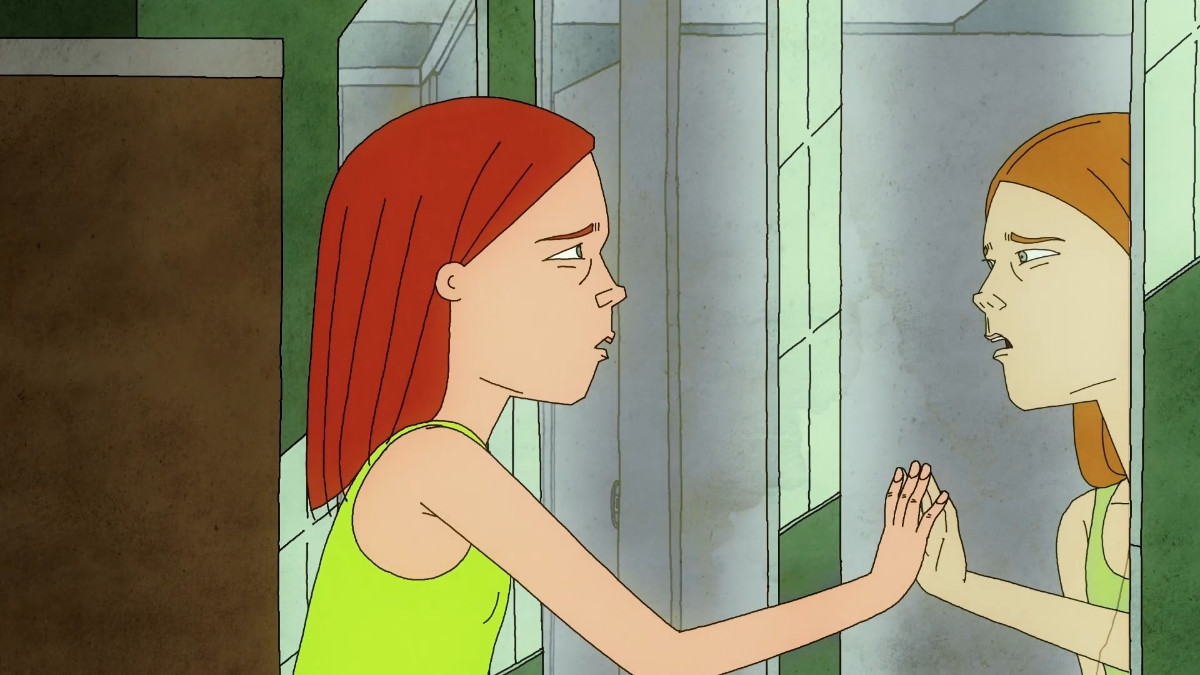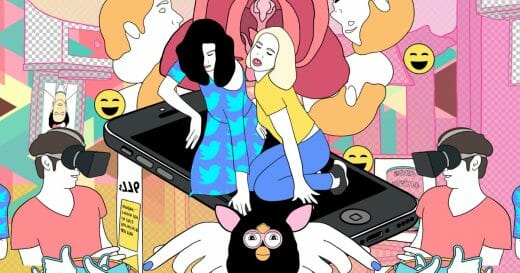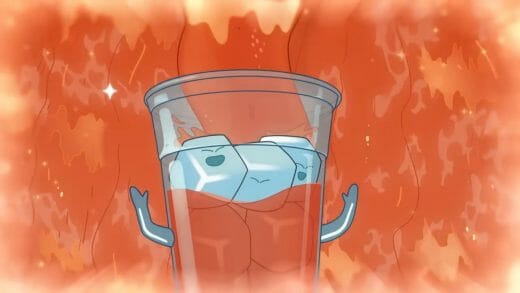
In A Crab in the Pool (original title: Un trou dans la poitrine), co-directors Alexandra Myotte and Jean-Sébastien Hamel dive into the relationship between Zoe and her younger brother Theo. Set in a run-down Montreal neighborhood during a sweltering summer, the film follows Zoe’s fiery anger and Theo’s fantastical escapism as they grapple with loss and find solace in each other.
This emotionally rich animated short has garnered critical acclaim. Among more than 30 prizes, it won the Audience Award for Best Animated Film at SXSW 2024 and also won the Best of the Year Vimeo Staff Pick and was shortlisted at the Oscars. We caught up with Alexandra and Jean-Sébastien, who wrote, directed and produced the film, to hear about the inspiration and process behind the project.
Could you share a bit about your animation backgrounds and career trajectories?
Alexandra: I originally studied other artistic endeavors, like music and dance. I always loved drawing and writing too. Somewhere along the way, someone suggested that I could combine all of these passions by going into animation. Eventually, I decided to learn animation at Concordia University.
I tried different types of animation, from hand-drawn 2D to animated puppets. In the early 2000s people were saying 2D animation was going to die, so everyone was getting into 3D animation. I tried it and didn’t like it at all, so I stuck with 2D.
I was lucky to have work after finishing university on small projects. I always preferred indie projects, and never had the goal to work on big projects with big studios. When Jean-Sébastien and I met, we started doing our own projects like web series. In 2020, we started doing short films and we really liked it.
Jean-Sébastien: I thought 3D animation was interesting as a new thing, but I’ve loved 2D since I was a kid. I was always waiting to watch cartoons on the weekend and I love comic books, movies and TV series. I learned everything myself, I’m a self-taught animation director. Alongside animation, I’ve also done directing and editing live action series and commercials, for nearly 20 years.
When I met Alexandra, my animation career started. We were working on a music video together for the band Karkwa that would be on Musique Plus.
The video was really successful and went to #1 on Musique Plus. Our second video, also for the band Karkwa, won best video of the year in Quebec. It was this work that made me realize then that I wanted animation to be a big part of my life.
It was also at this time that Alexandra and I fell in love and became a couple. We’ve now made a few projects together. It took time to see how each other works, but we don’t have big egos when it comes to creating; the film comes first!
You worked together as a team to write, direct, and produce A Crab in the Pool. What inspired the film’s story?
Alexandra: The film was inspired by our own story, because I had breast cancer in 2017. It wasn’t until a couple years after the cancer that I became interested in creating a film on that subject. However, I didn’t want to make a film that was biographical, I preferred that it just be inspired by my experience.
Jean-Sébastien’s mom also had breast cancer, but again, I didn’t want to create a story that was too much about Jean-Sébastien and I’s life. When we do animation, we try to be wild and psychedelic because we want to enjoy the fact that we are doing animation, not a story that could be live action. That’s why there are all those elements of fantasy, and because the characters are young, it’s easier to bring that element of fantasy into it.
When we show the movie and we’re in the audience, almost every time someone will come up to us and tell us, ‘I lived that’, or ‘my mother is sick.’ It’s really meaningful to us when people feel comfortable sharing this with us, because the process of healing is long, and you need a sense of community. Everyone knows someone who has or had cancer, but we rarely talk about it.
Jean-Sébastien: Although the film isn’t autobiographical, we can see ourselves in it. Theo kind of represents me and Zoe represents Alexandra. Sometimes at night, she wakes up terrified, thinking of dying. I was and am too worried that the cancer will come back. Even though Alexandra’s sickness is gone, the knowledge that it could happen again is scary. And so Theo is kind of like that, he is sad inside, but still tries to live a happy life.
My goal with this film was to make this story feel real, while still being fantastical. When we were discussing the end of the film, I was thinking of the film Portrait of a Lady on Fire, and how it made me feel. It’s a movie set in the 19th century and follows a lesbian couple.
At the end of the movie, the characters’ love for each other is strong but also impossible because of the time period. I wanted A Crab in the Pool to feel like that, both happy and sad. The siblings will get back together, but it will be impossible for them to be completely happy. I think it ends well, even though it’s a tragedy. It’s a conflicting feeling, but that is life.
How did you go about getting funding for A Crab in the Pool?
Alexandra: This was an indie project, so we led the production and the funding. The process can be very tedious. Our main source of funding for A Crab in the Pool was a Canadian Council for the Arts grant, as well as a Longueuil Council for the Arts grant; we also got provincial and federal tax credits.
Since the success of A Crab in the Pool we’ve had people reach out to us for collaboration and we’ve gotten more attention in general. Financing is still hard though, even with this film’s success.
We’re making a new short, and it’s coming out soon. It’s more adult, with a darker subject matter. It doesn’t have a whimsical, psychedelic, or fun aspect to it like A Crab in the Pool does.
Jean-Sébastien: Honestly, we don’t dare to compare the amount of hours we work on a project with the amount of money we make from it. If we knew the actual amount of money we make, we would probably think twice about it. There are also hidden costs in making a film, for example, you have to consider the cost of promoting it. For A Crab in the Pool, we hired a publicist because if you don’t have one it’s gonna be very hard to compete for the Academy Awards.
Making A Crab in the Pool wasn’t a money-making endeavour, it is a life experience. We invested a lot of ourselves into it. But it’s still super rewarding, especially when we see the film recognized and praised. For example, being shortlisted for an Oscar for the film was really validating.
Could you describe the animation style of A Crab in the Pool, and how you decided on it? Any references you can mention?
Alexandra: While I know the animation is important, the story and the way it works is in my view more important. For A Crab in the Pool, we realized the animation didn’t need to be complex. The film is so much about the story and characters.
With this in mind, I wanted to land on a style that was easy to animate, since I was the only one drawing. I also wanted it to be inventive in how we went from one scene to another. The style of the film has been compared a lot to Mike Judge. But we were also inspired by 1990s MTV programs Liquid Television. I really like anime as well, so that was a source of inspiration for me.
We’re given glimpses into Zoe and Theo’s imaginations, which are very distinct from each other. How do these sequences help to communicate to viewers how the two children are processing their grief differently?
Jean-Sébastien: The glasses are something from my childhood, something I did with my sister. She used to get motion sickness when we drove in the car. I used the “glasses” to try to trick her out of being sick. I have also done this with my niece, who really liked it too.
We thought the “glasses” would be a nice way to signal when Theo is seeing fantastical things, through the lens of his imagination. And often, what he sees represents his struggles. For example, when Theo vomits the crab, it represents those situations where you don’t want to say something because it’s just too difficult and horrible to say out loud.
We transitioned the fantastical sequences to be more psychedelic at the start of the film, and slowly become more realistic. This was a way to slowly reveal the childrens’ pain.
Alexandra: Zoe’s imagination is more body horror. The bathroom scene is supposed to represent her mind, and how she feels.
Jean-Sébastien and I have a dynamic where I’m usually more cerebral, I’ll bring the fancy puzzles and transitions. Jean-Sébastien pushes for being more emotional. For example, during the first draft I didn’t show the mother’s mastectomy, but Jean-Sébastien pushed for that to be shown.
The beginning of the story is more from my mind, and as the story develops, we go deeper into the subject, which becomes more emotional.
What’s been the most exciting, or fulfilling part about making A Crab in the Pool?
Jean-Sébastien: In making A Crab in the Pool we discovered a whole community, which has been really special because it can be isolating making a film at home. We’ve made many new friends as passionate as we are and had the opportunity to travel for 3 months last year, thanks to the film. It’s amazing to think that all of this happened because of an idea Alexandra had, that she presented to me three years ago.
Alexandra: Yes, it has been awesome meeting people through the film, and making friends along the way. Short films often aren’t really known by the mainstream, so it has been a nice experience to meet so many like-minded people throughout the process.
- Want to see more of A Crab in the Pool? Be sure to watch the short and director’s commentary on Vimeo and follow the directors Alexandra Myotte and Jean-Sébastien Hamel on Instagram.
- Ready to start production on your animated short? Artists can download a 21-day trial of Toon Boom Harmony.



